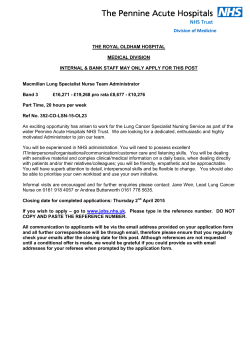
Stereotactic Body Radiotherapy for NSCLC
RADIOTHERAPY PROTOCOL Document Title: Document Type: Stereotactic Body Radiotherapy for Non-Small Cell Lung Cancer (54-60 Gy in 3-8 fractions) Clinical Guideline Subject: Standard Care Plan Approved by: Currency: Review date: Author(s): Standard care plan for stereotactic body radiotherapy for non-small-cell lung cancer References Lagerwaard FJ, Haasbeek CJ, Smit EF et al. Outcomes of risk-adapted fractionated stereotactic radiotherapy for stage I non-small cell lung cancer. Int J Radiat Oncol Biol Phys 2008;70:685-92 Nagata, Y., K. Takayama, Y. Matsuo, et al., Clinical outcomes of a phase I/II study of 48 Gy of stereotactic body radiotherapy in 4 fractions for primary lung cancer using a stereotactic body frame. Int J Radiat Oncol Biol Phys 2005. 63(5): p. 1427. Nyman, J., K.A. Johansson, and U. Hulte?n, Stereotactic hypofractionated radiotherapy for stage I non-small cell lung cancer - Mature results for medically inoperable patients. Lung Cancer, 2006. 51(1): p. 97. Onishi, H., H. Shirato, Y. Nagata, et al., Hypofractionated stereotactic radiotherapy (HypoFXSRT) for stage I non-small cell lung cancer: updated results of 257 patients in a Japanese multi-institutional study. J Thorac Oncol, 2007. 2(7 Suppl 3): p. S94-100. Senan S, Burgers S, Samson MJ, van Klaveren RJ, Oei SS, van Sornsen de Koste J, et al. Can elective nodal irradiation be omitted in stage III non-small-cell lung cancer? Analysis of recurrences in a phase II study of induction chemotherapy and involved-field radiotherapy. Int J Radiat Oncol Biol Phys 2002;54:9991006. Filename Last modified Last printed Page Agreed by (on behalf of team) 1.NSCLC%20_SBRT_Care%20plan[1] 27-Mar-15 27-Mar-15 1 of 11 Neil Bayman Care Plan Template Stereotactic Body Radiation Therapy (SBRT) for Patients with Early Stage Non-small Cell Lung Cancer: A Resource. UK SBRT Consortium, September 2009 Timmerman, R., R. McGarry, C. Yiannoutsos, et al., Excessive toxicity when treating central tumors in a phase II study of stereotactic body radiation therapy for medically inoperable early-stage lung cancer. J Clin Oncol, 2006. 24(30): p. 4833-9. Wulf, J., U. Hadinger, U. Oppitz, et al., Stereotactic radiotherapy of targets in the lung and liver. Strahlentherapie und Onkologie, 2001. 177(12): p. 645. Patient group Early stage NSCLC not suitable for surgery Clinical stages of: T1N0M0, T2 (≤5cm) N0M0 or T3 (≤5cm) N0M0 Indications Early stage NSCLC not suitable for surgery (see above) Lesion not within a previous radical radiotherapy field Any histological subtype of NSCLC MDT consensus of NSCLC if not able to confirm histologically ECOG PS 0-2 (selected cases with PS 3) Radiotherapy target volume is likely to be within radiotherapy planning constraints as judged by a clinical oncologist The UK SBRT consortium currently recommends that treatment should be reserved for peripheral lesions outside a 2cm radius of main airways and proximal bronchial tree. However there is emerging data that proximal tumours can be safely treated with minimal toxicity using 8 fractions (see Lagerwaard paper), and such tumours may be treated in the future. Cautions Adequate lung function (typically FEV1 >40% predicted and KCO >40% predicted). However, the evidence for correlation of lung function with respiratory toxicity is poor, hence these parameters serve only as a guide. Therefore, radical treatment is not precluded with lung function below these arbitrary levels with careful patient consent and consideration of anticipated PTV and V20. Evidence Regimes recommended by the UK SBRT consortium for SBRT treatment of NSCLC in the UK are 54Gy in 3 fractions, 60Gy in 5 fractions and 60Gy in 8 fractions. There are many retrospective data supporting excellent outcomes with these dose and fractions. Outcome Retrospective data gives local control of 80-95% at 3 years which is superior to standard conformal external beam radical radiotherapy, and comparable local control to surgery. 2 year overall survival ranges from 65% to 90%, again superior to Page 2 of 11 27/03/2015 Care Plan Template the predicted 45% 2 year overall survival from radical external beam radiotherapy (see table 1). Toxicity Atelectasis ≥ Grade 2 occurs in less than 5 %, pneumonitis ≥ Grade 2 occurs in about 5%, rib fractures occur in 5-20%. These figures however include data from RTOG 0236 which included treatment of proximal tumours, and treated tumours in contact with chest wall with 3 fractions. Our practice excludes proximal tumours and we treat tumours in contact with chest wall with 5 fractions, and we expect lower toxicities. Table from Clinical Review of Evidence for SBRT, National Radiotherapy Implementation Group, 2011 1. Initial investigations and work up prior to start of treatment 1.1. Diagnostic review and work up should usually include: Pathology/Cytology confirmed diagnosis of NSCLC (MDT consensus of NSCLC diagnosis if not able to confirm histologically) Stage of disease determined and documented o CT Abdomen/thorax o Bronchoscopy o PETCT o EBUS/mediastinoscopy if radilogically suspicious mediastinal lymph nodes o Biopsy of supraclavicular lypmph node if radiologically suspicious of malignancy Clinical assessment and documentation of current disease related symptoms Performance status recorded Co-morbidities recorded Smoking status recorded FH recorded Concomitant medications recorded and stopped if necessary Lung function test desirable Page 3 of 11 27/03/2015 Care Plan Template Patient consented for aims, practicalities and toxicity of radical external-beam radiotherapy 1.2. MDT meeting Case must have been through the relevant diagnostic MDT prior to commencing treatment. 2. Stereotactic Body Radiotherapy Technique for NSCLC http://discover/documents/default.aspx?Details=Y&Doc_ID=5077 (see also Senan, S., et al., Literature-based recommendations for treatment planning and execution in high-dose radiotherapy for lung cancer. Radiother Oncol, 2004. 71(2): 139-46. ) Please also refer to the UK SBRT consortium guidelines. 2.1. Patient treatment position and set-up Supine, breathing normally using an external immobilisation device with arms immobilised above the head in most cases. Exceptionally, for patients with limited arm movement or apical cancer, arms may be positioned by the patients’ side and consideration should be given to a 5 pt shell fixation to aid stability. Set up should be by reference to anterior and lateral tattoos on stable areas of skin and bony anatomical landmarks. 2.2. Patient data acquisition More consideration needs to be given to patient comfort as well as their positional stability and the reproducibility of their set-up. Patients should be placed supine in a comfortable and reproducible position, with their arms above their heads, although alternative positions may be required for individual patients. Devices such as customized vacuum bags can be used to achieve patient comfort and stability. Custom immobilisation devices can also be used for immobilisation and to facilitate abdominal compression. The immobilization device should allow for patient and tumour imaging as necessary using CT, CBCT and/or fluoroscopy, and not interfere with dose calculation or treatment delivery. In addition, analgesics +/- mild sedatives and oxygen can be considered to help the patient maintain the treatment position during each fraction. Once the patient has been appropriately positioned, 4DCT is used to assess tumour motion. 2.3. Target volume delineation Treatment will be planned based on information from bronchoscopy, PET-CT scan if available and mediastinoscopy or thoracotomy, if performed in addition to CT Page 4 of 11 27/03/2015 Care Plan Template findings. Target volume delineation will be done using both the mediastinal and lung windows. Gross Tumour Volume (GTV) = The GTV is defined as the radiologically visible tumour in the lung, contoured using lung settings. Mediastinal windows may be suitable for defining tumours proximal to the chest wall. Where available information from PET/CT will be incorporated into delineating the GTV. Clinical Target Volume (CTV) = The CTV is the GTV with no margin for microscopic disease extension. This is the accepted standard in the majority of SBRT trials. Internal Target Volume (ITV) = tumour volume obtained using a 4DCT scan. This is defined as tumour contoured using either the (i) maximum intensity projection scan, (ii) maximum inspiratory and expiratory scans or (iii) as contoured on all 10 phases of a 4DCT scan. Planning Target Volume (PTV) = ITV expanded by isotropic margins of 5mm. 2.4. Organs at risk (delineation and dose constraints) It is recommended that the following organs at risk are delineated on the CT planning dataset. Spinal cord The spinal cord should be contoured on all slices based on the bony limits of the spinal canal. Oesophagus The oesophagus will be contoured using mediastinal windowing on CT to correspond to the mucosal, submucosa, and all muscular layers out to the fatty adventitia Brachial Plexus The brachial plexus will be contoured using the subclavian and axillary vessels as a surrogate. This neurovascular complex will be contoured starting proximally at the bifurcation of the brachiocephalic trunk into the jugular/subclavian veins (or carotid/subclavian arteries), and following along the route of the subclavian vein to the axillary vein ending after the neurovascular structures cross the 2nd rib. Heart The heart will be contoured along with the pericardial sac. The superior aspect (or base) for purposes of contouring is defined as the superior aspect of pulmonary artery (as seen in a coronal reconstruction of the CT scan) and extended inferiorly to the apex of the heart. Trachea and proximal bronchial tree The trachea and bronchial tree will be contoured as two separate structures using lung windows. For this purpose, the trachea will be divided into two sections: the proximal trachea and the distal 2 cm of trachea. The proximal trachea will be contoured as one structure, and the distal 2 cm of trachea will be included in the structure identified as proximal bronchial tree. Differentiating these structures in this fashion will facilitate the eligibility requirement for excluding patients with tumours within 2 cm of the proximal bronchial tree. Proximal trachea Page 5 of 11 27/03/2015 Care Plan Template Contours should begin 10cm superior to superior extent of PTV or 5cm superior to the carina (whichever is the more superior) and continue inferiorly to the superior aspect of the proximal bronchial tree. Proximal bronchial tree This will include the most inferior distal 2cm of trachea and the proximal airways on both sides. The following airways will be included: distal 2cm trachea, carina, right and left mainstem bronchi, right and left upper lobe bronchi, the bronchus intermedius, right middle lobe bronchus, lingular bronchus, and the right and left lower lobe bronchi. Whole lung Both lungs should be contoured as one structure using pulmonary windows. All inflated and collapsed lung should be included. However, GTV and trachea/ipsilateral bronchus as defined above should not be included. The Lungs-GTV should be kept at V20< 10%, and V12.5<15%. 2.5. Dose prescription The dose prescription will be chosen such that 95% of the target volume (PTV) receives at least the nominal fraction dose. Radical Radiotherapy doses: 54Gy in 3 fractions or 60Gy in 5-8 fractions. It is recommended that the inter-fraction interval be at least 40 hours, with a maximum interval of ideally 4 days between treatment fractions 2.6. Verification: Standard procedure involves an online cone beam CT correction strategy outlined below. Page 6 of 11 27/03/2015 Care Plan Template Patient Positioned as per Set-up Notes ACQUIRE CBCT 1 Align the clipbox to bony anatomy and perform automatic matching and assess rotation (tolerance <5 degrees) PERFORM IMAGE REGISTRATION: 3 step process 3 mm tolerance 2 Manually match directly to the tumour in the localization mode. Match ITV contour to visible tumour on CBCT 3 Match outside 3mm tolerance Match within 3mm tolerance Check position of critical OARs and check for changes in Patient’s internal anatomy Shift patient and acquire verification CBCT and ENSURE shift is within tolerance (3mm) Commence treatment and repeat CBCT; (a) prior to any non-coplanar beams (b) if any significant patient movement (c) if treatment time exceeds 30 mins 2.7. Treatment Delays: Every effort should be made to deliver the prescribed dose of radiotherapy within the standard timeframe. If unavoidable delays occur, patient will be treated on the next available treatment date. The consultant will need to be notified. It is aimed that despite potential delays all treatment will complete within 4 weeks. As overall treatment time will be less than 4 weeks, there is no need for compensation for tumour repopulation. Page 7 of 11 27/03/2015 Care Plan Template 3. On treatment assessments 3.1. Clinical assessment by medical team with every fraction including Graded documentation of toxicity Assessment of disease related symptoms Performance status recorded 3.2. Management of treatment related toxicity 3.2.1 Radiation oesophagitis Grade 2 oesophagitis – optimise analgesia (consider sucralfate suspension, paracetamol mucilage, codeine phosphate liquid, oromorph, fentanyl patch). Advise soft diet/oral dietry supplements if required Grade 3 oesophagitis - treat as for grade 2 oesophagitis but also consider admission to The Christie/dietician input/pareteral nutrition if required. Every effort should be made to continue radiotherapy. Avoid placement of nasogastric tubes Grade 4 oesophagitis – As for grade 3 oesophagitis but radiotherapy should be stopped. 3.2.2 Radiation Pneumonitis Grade 2 pneumonitis - Consider oral steroids/sntibiotics/antifungals Grade 3 pneumonitis – consider admission to The Christie for high dose IV steroids/oxygen/antibiotics/antifungals. Alert critical care team. Consider stopping radiotherapy Grade 4 pneumonitis – as for grade 3 but will require admission to critical care and consider ventilatory support if appropriate. Stop radiotherapy. 3.2.3 Radiation dermatitis Topical treatment with aqueous cream/1% hydrocortisone cream if required Page 8 of 11 27/03/2015 Care Plan Template Post treatment follow-up 2 week and 4 week post-treatment review with clinical assessment for residual treatment related toxicity and appropriate investigations at discretion of clinician. Further follow-up as outlined below: Procedure Medical History Physical Examination Weight ECOG score Lung function test CT scan thorax and abdomen Chest Xray Adverse event monitoring QOL Months post RT 3 6 9 12 18 24 30 36 42 48 54 60 X X X X X X X X X X X X X X X X X X X X X X X X X X X X X X X X X X X X X X X X X X X X X X X X X X X X X X X X X X X X X X X X X X X X X X X X Page 9 of 11 X X X X X X X X X X X X X X X X X 27/03/2015 Care Plan Template Appendices ECOG PERFORMANCE STATUS* Grade ECOG 0 Fully active, able to carry on all pre-disease performance without restriction 1 Restricted in physically strenuous activity but ambulatory and able to carry out work of a light or sedentary nature, e.g., light house work, office work 2 Ambulatory and capable of all selfcare but unable to carry out any work activities. Up and about more than 50% of waking hours 3 Capable of only limited selfcare, confined to bed or chair more than 50% of waking hours 4 Completely disabled. Cannot carry on any selfcare. Totally confined to bed or chair 5 Dead CTCAE v4.0 Skin and Subcutaneous Tissue Disorders Grade Adverse Event 1 2 3 4 5 Oesophagitis Asymptomatic; clinical or diagnostic observations only; intervention not indicated Symptomatic; altered eating/swallowing; oral supplements indicated Severely altered eating/swallowing; tube feeding, TPN or hospitalization indicated Life-threatening consequences; urgent operative intervention indicated Pneumonitis Asymptomatic; clinical or diagnostic observations only; intervention not indicated Symptomatic; medical intervention indicated; limiting instrumental ADL Severe symptoms; limiting self care ADL; oxygen indicated Life-threatening respiratory compromise; urgent intervention indicated (e.g., tracheotomy or intubation) Rash: dermatitis associated with radiation Faint erythema or dry desquamation Moderate to brisk erythema; patchy moist desquamation, mostly confined to skin folds and creases; moderate oedema Moist desquamation other than skin folds and creases; bleeding induced by minor trauma or abrasion Skin necrosis or ulceration of full thickness dermis; spontaneous bleeding from involved site; skin graft indicated Dyspnoea Shortness of breath with moderate exertion Shortness of breath with minimal exertion; Limiting instrumental ADL Shortness of breath at rest; limiting self care ADL Life-threatening consequences; urgent intervention indicated Death Fatigue Fatigue relieved by rest Fatigue not relieved by rest; limiting instrumental ADL Fatigue not relieved by rest; limiting self-care ADL - - Chest wall pain Mild pain Moderate pain; limiting instrumental ADL Severe pain; limiting self care ADL - Page 10 of 11 27/03/2015 Death Death Death Care Plan Template Cough Mild symptoms; nonprescription intervention indicated Moderate symptoms, medical intervention indicated Severe symptoms; limiting instrumental ADL Page 11 of 11 27/03/2015
© Copyright 2025











